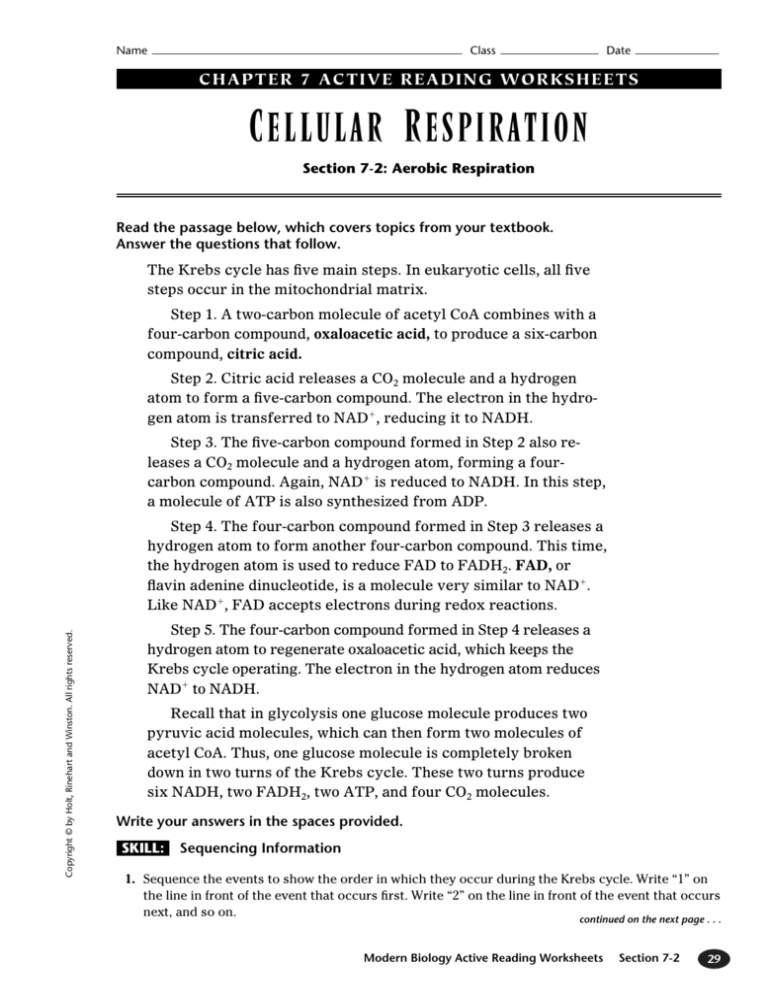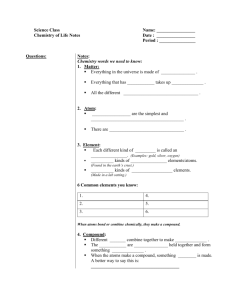
Name
Class
Date
CHAPTER 7 ACTIVE READING WORKSHEETS
C ELLULAR R ESPIRATION
Section 7-2: Aerobic Respiration
Read the passage below, which covers topics from your textbook.
Answer the questions that follow.
The Krebs cycle has five main steps. In eukaryotic cells, all five
steps occur in the mitochondrial matrix.
Step 1. A two-carbon molecule of acetyl CoA combines with a
four-carbon compound, oxaloacetic acid, to produce a six-carbon
compound, citric acid.
Step 2. Citric acid releases a CO2 molecule and a hydrogen
atom to form a five-carbon compound. The electron in the hydrogen atom is transferred to NAD, reducing it to NADH.
Step 3. The five-carbon compound formed in Step 2 also releases a CO2 molecule and a hydrogen atom, forming a fourcarbon compound. Again, NAD is reduced to NADH. In this step,
a molecule of ATP is also synthesized from ADP.
Copyright © by Holt, Rinehart and Winston. All rights reserved.
Step 4. The four-carbon compound formed in Step 3 releases a
hydrogen atom to form another four-carbon compound. This time,
the hydrogen atom is used to reduce FAD to FADH2. FAD, or
flavin adenine dinucleotide, is a molecule very similar to NAD.
Like NAD, FAD accepts electrons during redox reactions.
Step 5. The four-carbon compound formed in Step 4 releases a
hydrogen atom to regenerate oxaloacetic acid, which keeps the
Krebs cycle operating. The electron in the hydrogen atom reduces
NAD to NADH.
Recall that in glycolysis one glucose molecule produces two
pyruvic acid molecules, which can then form two molecules of
acetyl CoA. Thus, one glucose molecule is completely broken
down in two turns of the Krebs cycle. These two turns produce
six NADH, two FADH2, two ATP, and four CO2 molecules.
Write your answers in the spaces provided.
SKILL:
Sequencing Information
1. Sequence the events to show the order in which they occur during the Krebs cycle. Write “1” on
the line in front of the event that occurs first. Write “2” on the line in front of the event that occurs
next, and so on.
continued on the next page . . .
Modern Biology Active Reading Worksheets
Section 7-2
29
Name
Class
Date
a. Citric acid releases a CO2 molecule and a hydrogen atom to form a five-carbon compound.
b. A four-carbon compound is converted into oxaloacetic acid.
c. A five-carbon compound releases a CO2 molecule to form a four-carbon compound.
d. A molecule of acetyl CoA combines with oxaloacetic acid to produce citric acid.
e. A four-carbon compound releases a hydrogen atom to form another four-carbon compound.
Write your answers in the spaces provided.
2. The figure below shows the Krebs cycle. Using the information contained in the passage, write the
name of the compound at each lettered block on the lines below the figure. Use the following labels: “4-carbon compound,” “5-carbon compound,” “Oxaloacetic acid,” and “Citric acid.” You will
use a label more than once.
CoA
Acetyl CoA
a.
Step 1
CC
CO2 C
NAD+
CCCCCC
Step 2
e.
b.
CCCC
CCCCC
Step 5
Step 3
CO2 C
NAD+
NADH + H+
NAD+
ADP + phosphate
d.
c.
Step 4
CCCC
ATP
CCCC
FADH2
FAD
a.
d.
b.
e.
c.
Circle the letter of the phrase that best completes the statement.
3. Two completions of the Krebs cycle produce six NADH, two FADH2, four CO2, and
a. four glucose molecules.
b. two ATP molecules.
30
c. four ATP molecules.
d. Both (a) and (b)
Modern Biology Active Reading Worksheets
Section 7-2
Copyright © by Holt, Rinehart and Winston. All rights reserved.
NADH + H+
NADH + H+
5. Through synapsis, chromatids on homologous
chromosomes may come in contact with one
another and exchange genetic material.
6. d
SECTION 7-2: AEROBIC RESPIRATION
1. a.
b.
c.
d.
e.
2. a.
b.
c.
d.
e.
3. b
2
5
3
1
4
citric acid
5-carbon compound
4-carbon compound
4-carbon compound
oxaloacetic acid
CHAPTER 9
Fundamentals of Genetics
SECTION 9-1: MENDEL’S LEGACY
1.
2.
3.
4.
separate
one factor from each pair
fertilization
a pair of factors is segregated, or separated, during the formation of gametes
5. together
6. b
CHAPTER 8
Cell Reproduction
SECTION 8-1: CHROMOSOMES
1. Both males and females have two sex chromosomes, one of which is an X chromosome.The
second sex chromosome differs between males
and females. Males have a Y chromosome and
females have a second X chromosome.
2. Homologues are copies of an autosome, are the
same size as one another, and carry genes for
the same traits.
3. c
Copyright © by Holt, Rinehart and Winston. All rights reserved.
SECTION 8-2: CELL DIVISION
1.
2.
3.
4.
5.
6.
7.
8.
9.
10.
11.
12.
13.
14.
15.
c
a
d
b
a
d
c
a
d
a. Centrosome
b. Centromere
c. Spindle fibers
d. Nuclear envelope
Prophase
Metaphase
Anaphase
Telophase
b
SECTION 9-2: GENETIC CROSSES
1. a. to show the probability that certain traits will
be inherited by offspring
b. Each parent has one dominant allele (B) and
one recessive allele (b) for coat color.
c. Because each parent has one dominant allele,
both parents have black coat color.
d. Two homozygous offspring are predicted, one
with the genotype BB and one with the genotype bb.
e. 1 BB: 2 Bb: 1 bb
f. 3 black: 1 brown
2. Phenotype refers to the appearance of an organism as a result of its genotype, or how the traits
show in the organism.
3. d
CHAPTER 10
DNA, RNA, and Protein Synthesis
SECTION 10-1: DISCOVERY OF DNA
1. protease
2. DNase
3. The batch containing heat-killed S cells, DNase,
and live R cells resulted in the mice surviving.
4. b
SECTION 10-2: DNA STRUCTURE
SECTION 8-3: MEIOSIS
1. Sperm and egg cells each contain 23 chromosomes.
2. The fusion of sperm and egg results in a zygote.
3. Portions of the chromatids may break off and
attach to adjacent chromatids on the homologous chromosome.
4. Through crossing-over, genetic material is
exchanged between maternal and paternal chromosomes.
1. Sentence 2
2. DNA is made up of repeating subunits called
nucleotides.
3. It explains that each DNA molecule contains two
chains of nucleotides.
4. d
SECTION 10-3: DNA REPLICATION
1. DNA polymerases add new complementary
nucleotides, found floating freely inside the
nucleus, to the original strands of DNA.
2. Helicases move along the DNA molecule, separating the two strands by breaking the hydrogen
bonds between complementary nitrogenous
bases.
3. a
Modern Biology Active Reading Worksheets
Answer Key
203








